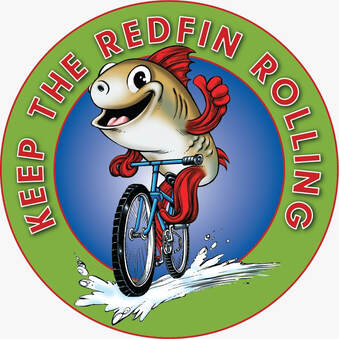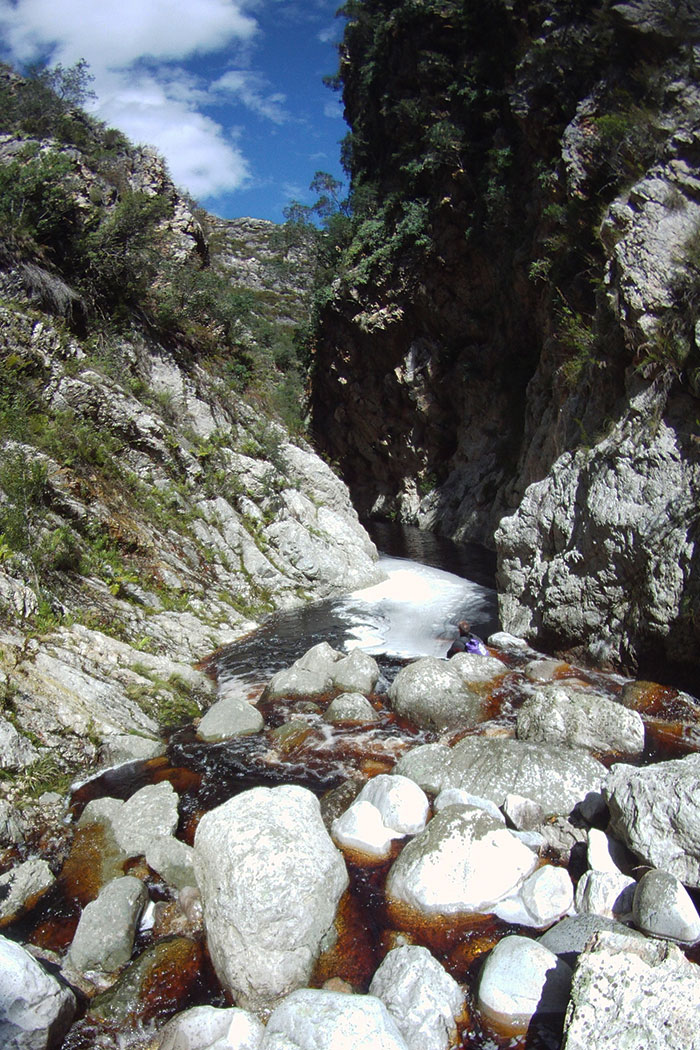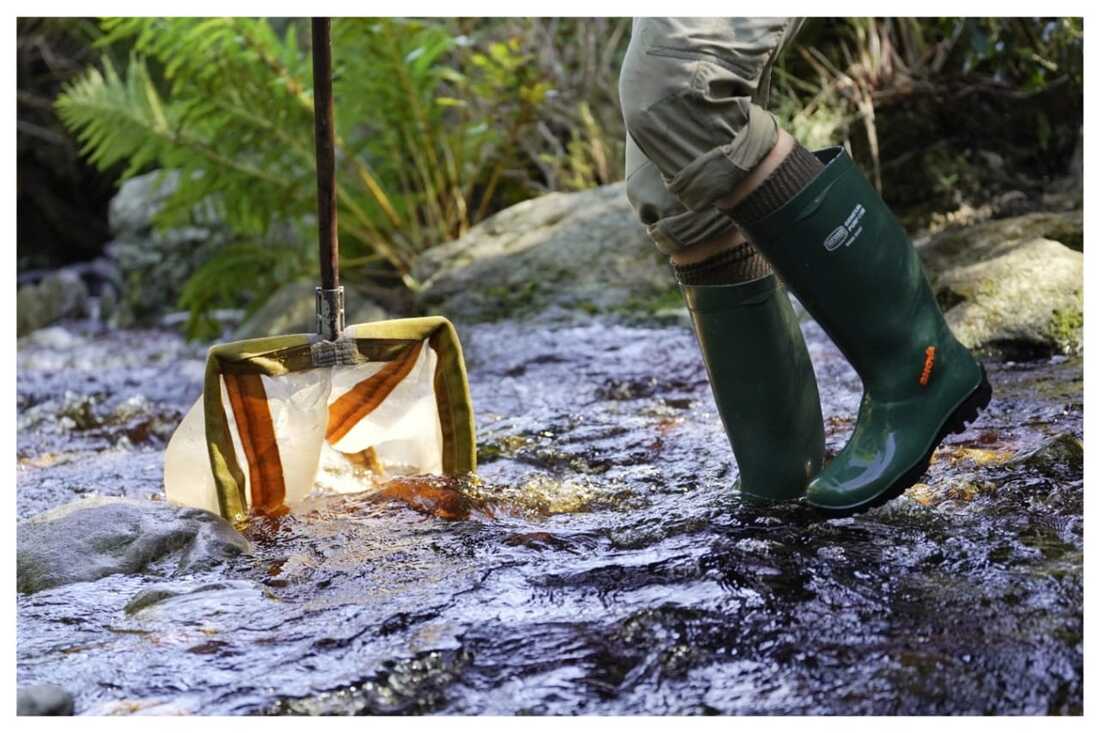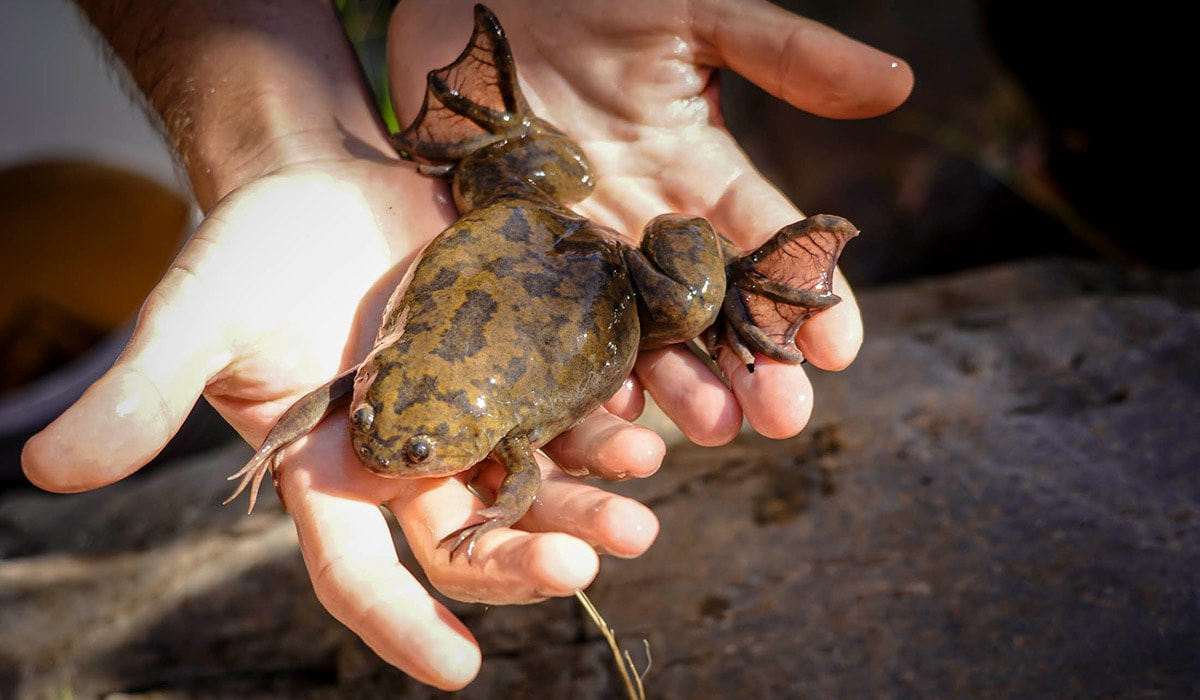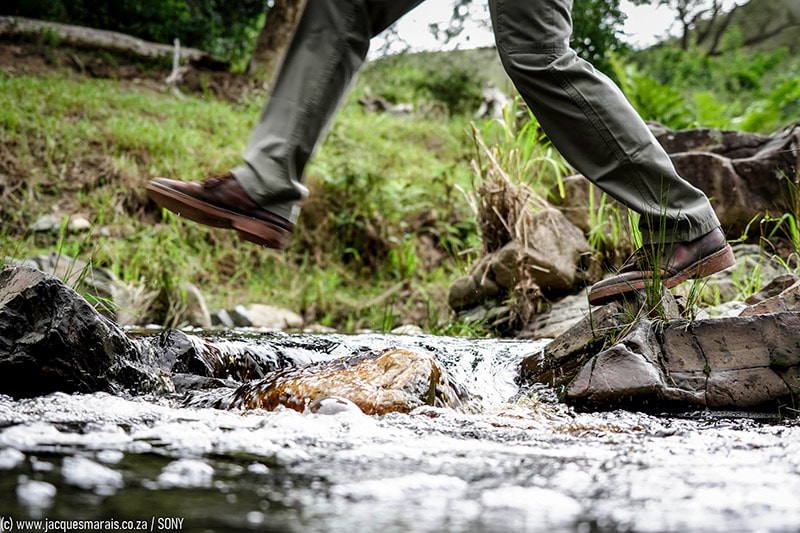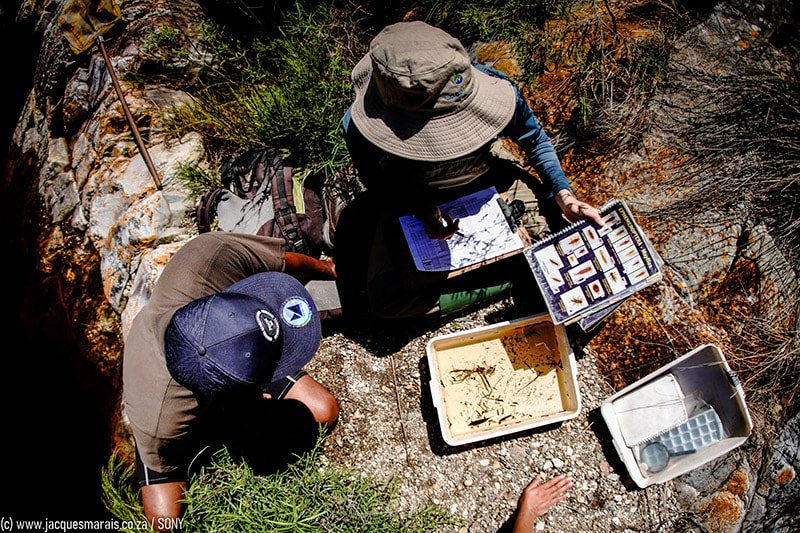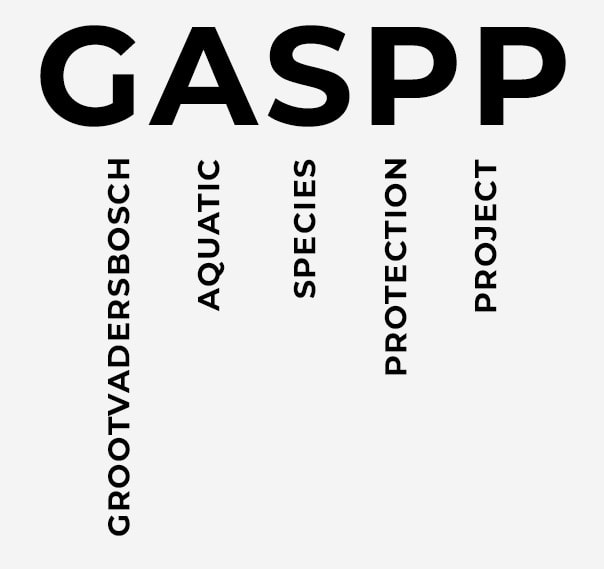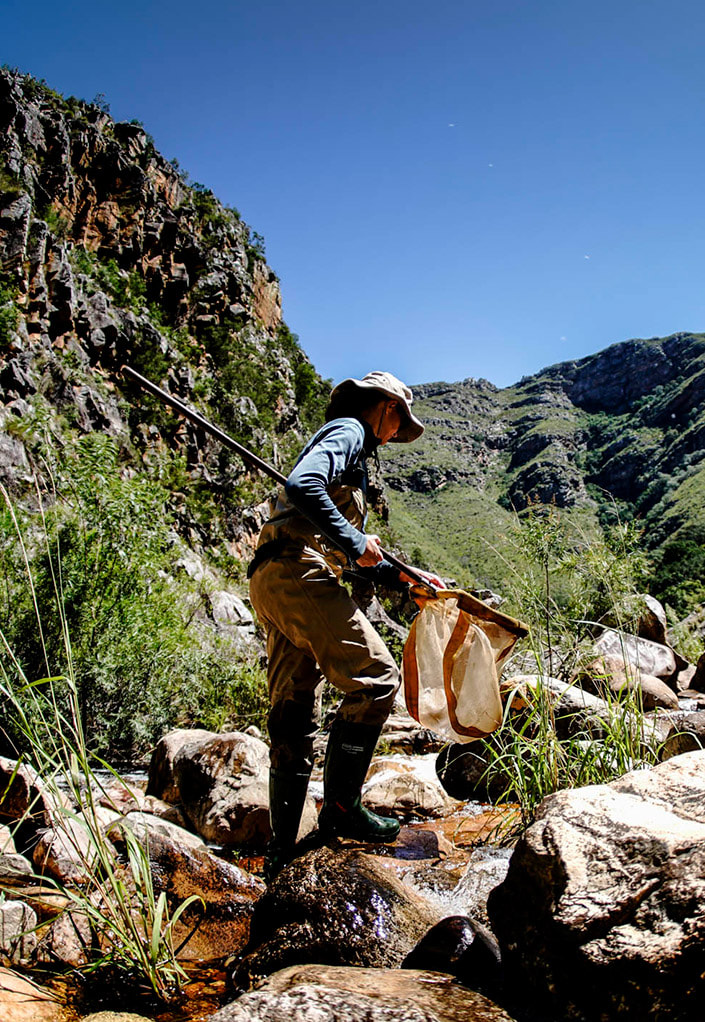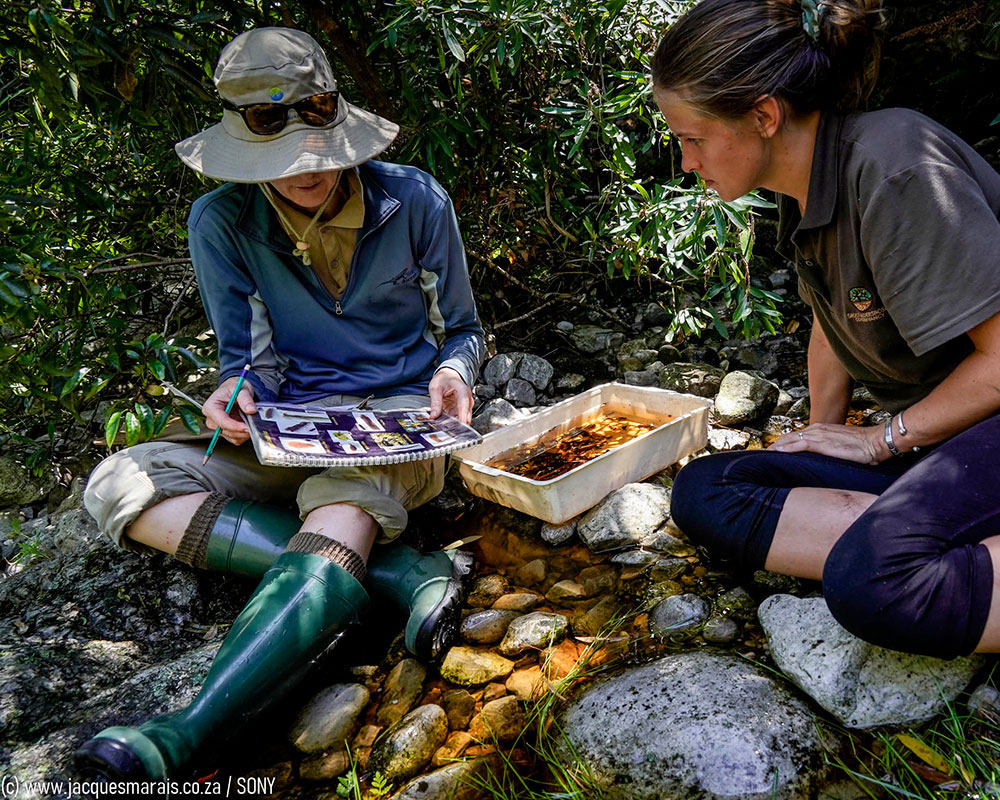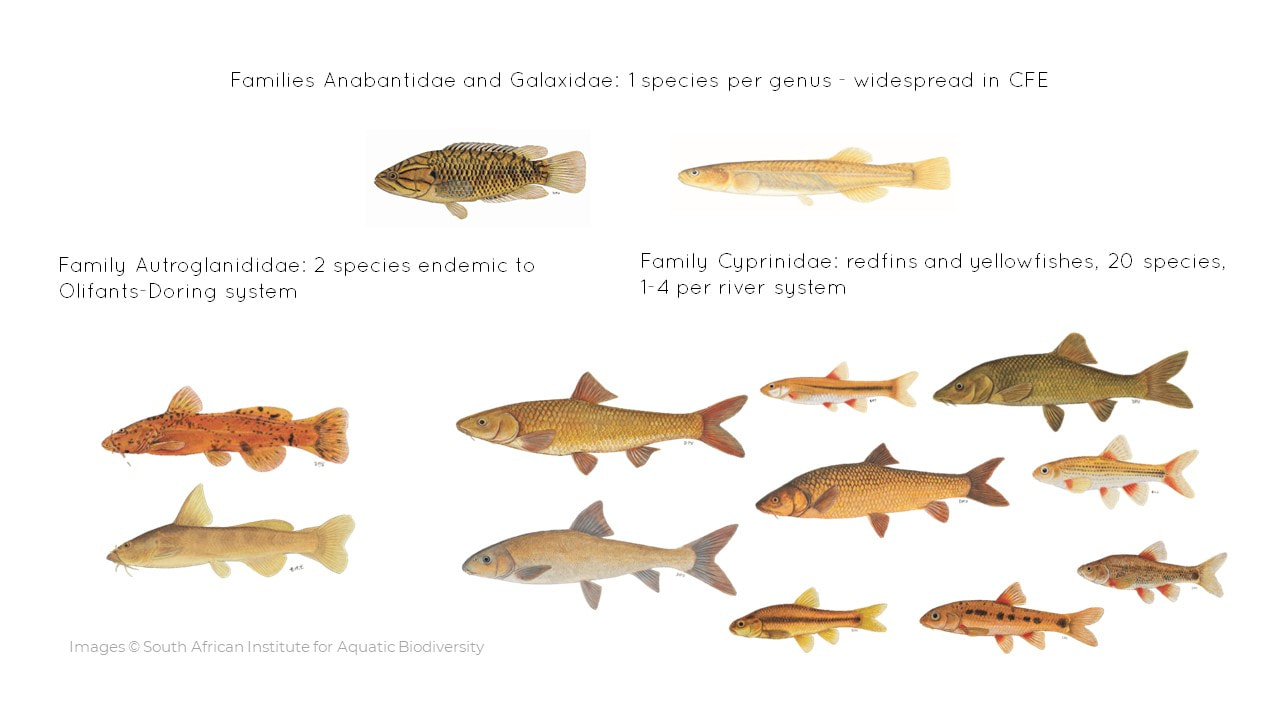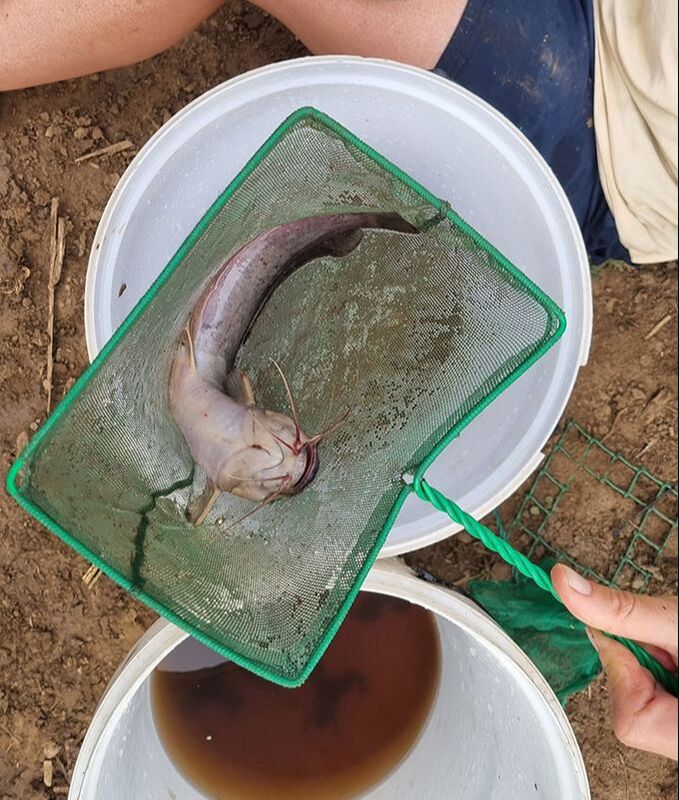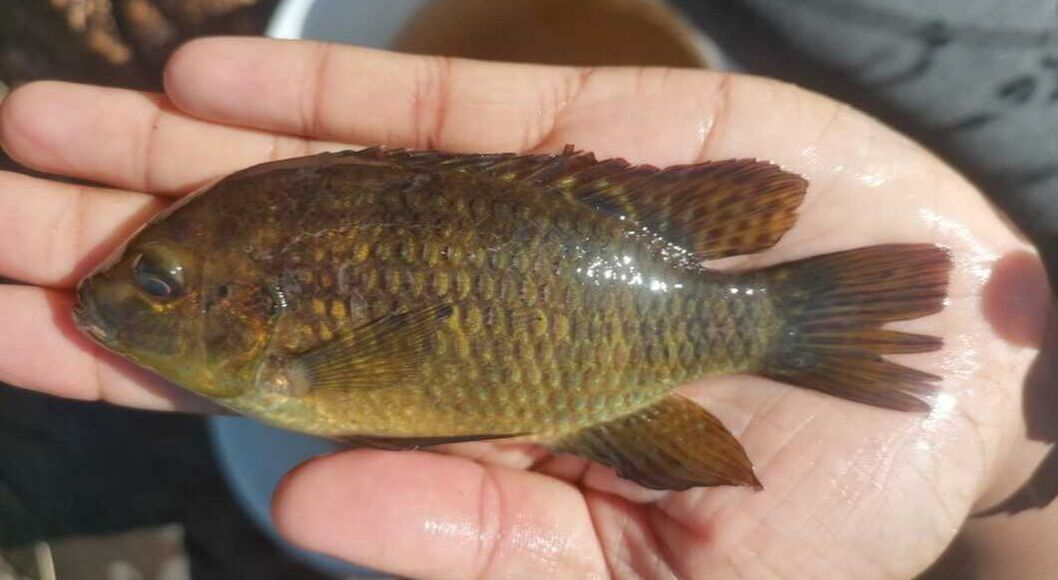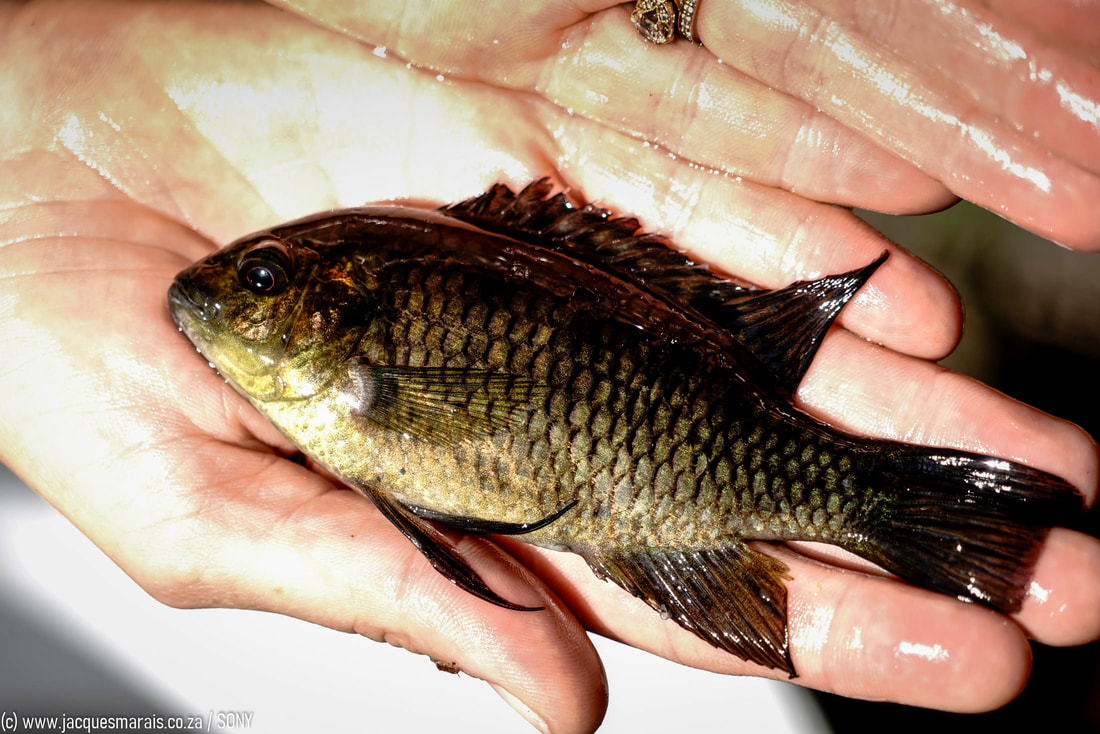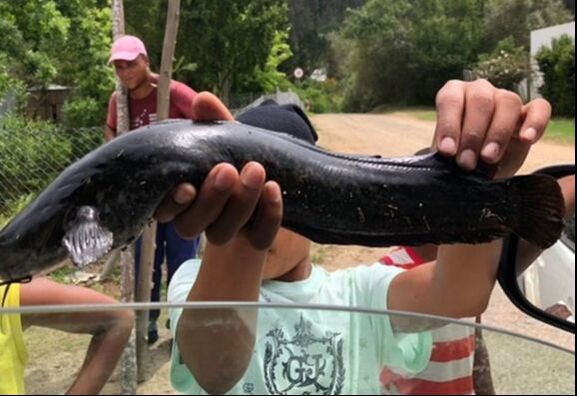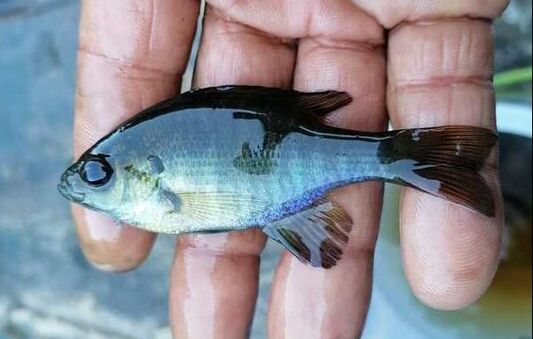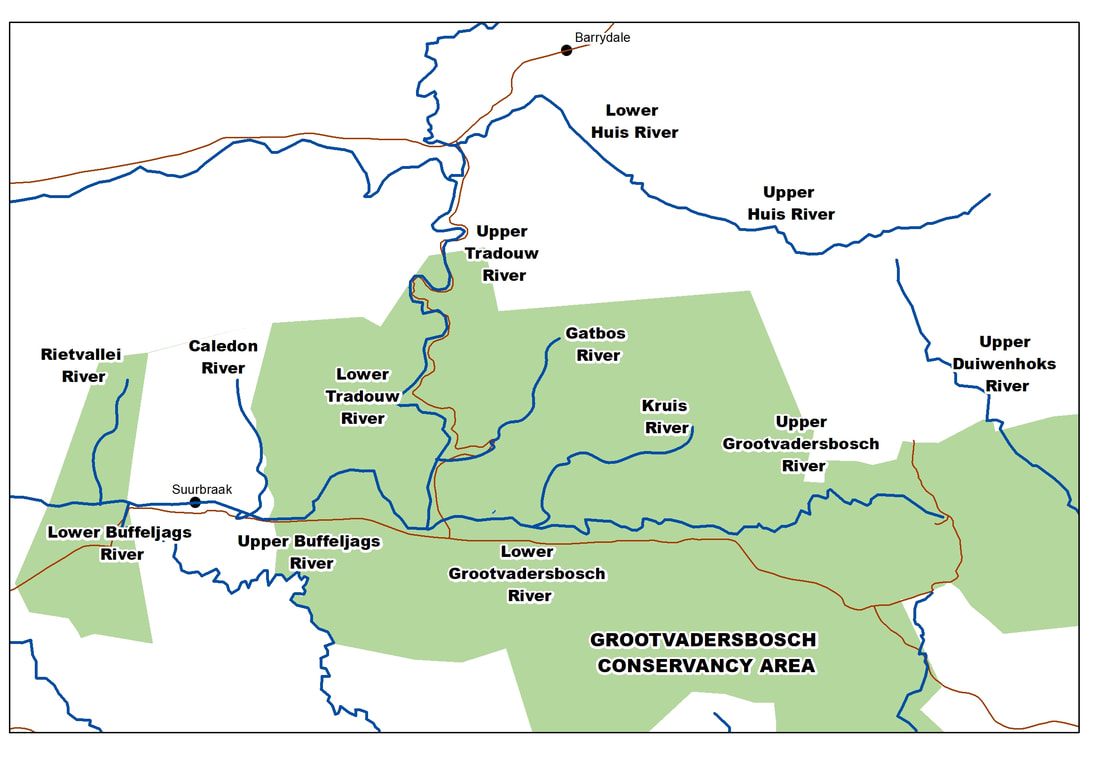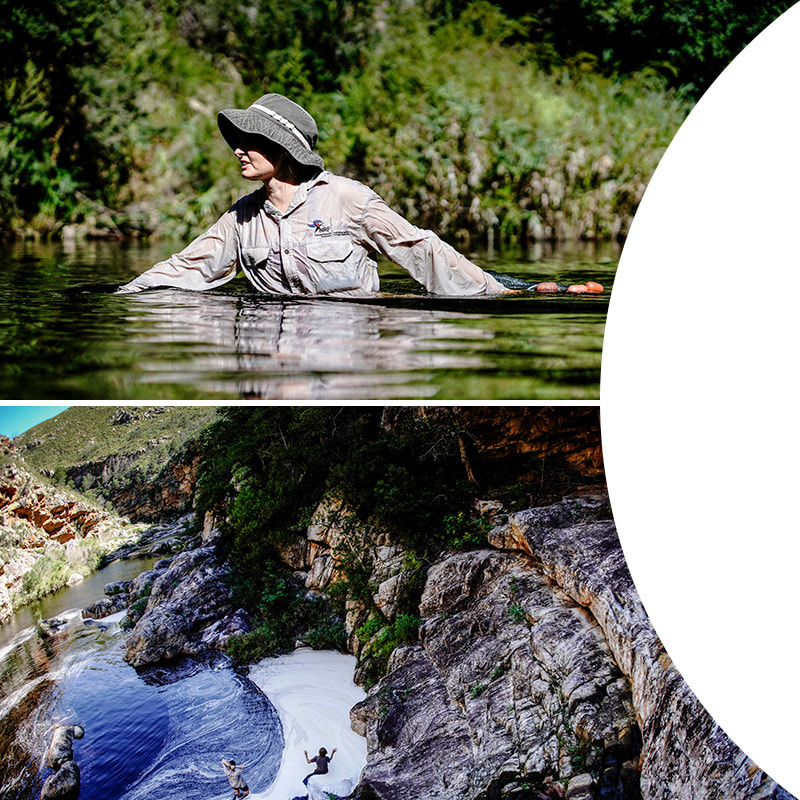WE ARE ALSO HOME TO GALAXIA
SPECIES, THE BREEDE RIVER REDFIN
AND THE BREEDE SANDELIA CAPENSIS.
THESE ARE CONSIDERED VULNERABLE, ENDANGERED OR CRITICALLY ENDANGERED.
These fish are the flagship species for our conservation projects to protect our rivers which provide vital ecosystem services that support livelihoods. Our rivers face severe threats, in particular from invasive alien predatory fish and alien vegetation along the riverbanks.
Over time, human activities have also impacted, including water abstraction and instances where the river’s flow has been modified.
Over time, human activities have also impacted, including water abstraction and instances where the river’s flow has been modified.
Project objectiveS
|
PROJECT SUMMARY
5Collaborative field trips between CN and GVBC staff between 2018 and 2022
|
51 Sites surveyed, >750 fish measured (ongoing)
|
SASS5Comprehensive fish survey and SASS5 aquatic invertebrate assessment for each site
|
56 Distribution records linked to voucher specimens and DNA samples.
|
|
5Education murals painted on schools and public spaces to promote awarenes
|
4A0 posters printed and placed in schools and local prominent sites to raise awareness
|
4Staff trained in Field work and SASS techniques
|
THAT’S WHY WE WORK TO RESTORE AND PROTECT THE RIVERS In The GROOTVADERSBOSCH CONSERVANCY
OUR PLAN:
SUPPORT US TO PROTECT OUR RIVERS: |
GROOT VADERS BOSCH CONSERVANCY TRUST
Bank: Standard Bank
Savings Account: 188099158
Branch: 051001
Indigenous freshwater fish
The freshwater fish of the Cape Fold Ecoregion consists of four families of fish. These are the Anabantidae and Galaxidae with one described species each, the Cyprinidae which are the perhaps better known redfins and yellowfishes…
….and finally the rock catlets which are endemic to the Olifants – Doring river system to the west of the province and not found in our systems.
….and finally the rock catlets which are endemic to the Olifants – Doring river system to the west of the province and not found in our systems.
3 of the 4 FAMILIES OF FISH in the Cape Fold Ecoregion are found in our area
|
Cape galaxias Galaxias zebratus
Cape kurper Sandelia capensis Longfin eel Anguilla mossambica |
Breede river redfin Pseudobarbus sp. nov. ‘breede’
Tradouw redfin Pseudobarbus burchelli |
Non-native freshwater fish
|
Banded tilapia kurper (Tilapia sparrmanii)
Largemouth bass (Micropterus salmoides) |
Sharptooth catfish (Clarias gariepinus)
Common carp (Cyprinus carpio) Bluegill (Lepomis Macrochirus) |
|
|
|
SUMMARY OF OUR RIVER SYSTEMS AND WHAT WE HAVE LEARNT THROUGH GASPP |
RIETVALLEI RIVER
High Mountain kloof flows into Grootvadersbosch SASS 2022: B (Good) Fish: Galaxias Conservation Questions: Why are Sandelia not found here. What is the range extension of Galaxias? Conservation Importance: Maintain flow as the tributaries are important to maintain water quality in the main Buffeljags LOWER BUFFELJAGS RIVER
Below Suurbraak. River refreshed by mountain streams SASS 2022: B (Good) Fish: Tilapia, Catfish Conservation Questions: Need to better understand the impact of invasive fish. Implications of municipal and agricultural water use on water quality Actions: Monitor water quality and contain spread of invasive fish CALEDON RIVER
High Mountain kloof flows into Buffeljags River above Suurbraak SASS 2022: A (Natural) Fish: Sandelia Conservation Questions: Better understanding on water abstraction on fish population. What is the range extension of Sandelia? Conservation Importance: Maintain flows as the tributaries are important to maintain quality in the main Buffeljags. UPPER BUFFELJAGS RIVER
River section from confluence with Tradouw River and the town of Suurbraak SASS 2023: C (Fair) Fish: Catfish, Tilapia Conservation Actions: Monitor water quality and spread of invasive fish LOWER TRADOUW RIVER
Below waterfall barrier before confluence with Buffeljags SASS 2023: B (Good) Fish: Tilapia Conservation Actions: Monitor water quality and spread of invasive fish populations. UPPER TRADOUW RIVER
Below town of Barrydale to waterfall barrier near end of pass. River quality is declining and Tradouw redfin population in decline. SASS 2023: D (Critically Modified) Fish: Tilapia, Bluegill, Indigenous eels Conservation Actions: Declining water quality due to low flows from Huis River, Extensive invasive fish population. Urgent action required to improve water quality and flow, no redfin caught. LOWER HUIS RIVER
Flows through agriculture and town of Barrydale. River often stops flowing. SASS 2023: E (Critically Modified) Fish: Large Redfin population (with parasitic infestations) Conservation Actions: Ensure consistent flows all year and limit agriculture and municipal use. Alien clearing along rivers required. Ensure adequate water quality and flow. Redfin population large but parasites visible UPPER HUIS RIVER
Upper Mountain stream with no agricultural activity SASS 2023: C (Fait) Fish: Tradouw Redfin in pool at donkergat and one above. None above barrier Conservation Actions: Critically important habitat for Tradouw redfin survival. Investigate expanding population upstream of donkergat barrier. Maintain sufficient water in breeding pool at all times. Unclear why SASS score dropped above donkergat. GATBOS RIVER
High Mountain kloof flows into tradouw river Conservation Questions: A (Natural) Fish: No fish recorded to date Conservation Actions: Maintain flows as the tributaries are important to maintain quality in the Tradouw. LOWER GROOTVADERSBOSCH RIVER
River flows through agricultural activity before meeting Tradouw river. SASS 2022: D (Modified) Fish: Catfish, Tilapia, galaxia Conservation Actions: Investigate sources of pollution and interventions to improve water quality, impact of floods resulted in unusual siting of galaxia that must have been washed down KRUIS RIVER
Flows from Kleinberg through gorge. Mountain stream in good condition which refreshes main Grootvadersbosch stream SASS 2023: B (Good) Fish: Galaxias and Sandelia Conservation Actions: Maintain flows as the tributaries are important to maintain quality in the main Grootvadersbosch UPPER GROOTVADERSBOSCH RIVER
River section from Nature Reserve boundary through light agriculture. Very important fish habitat SASS 2022: C (Fair( Fish: Sandelia, Breede Redfin, Galaxias, Tilapia, Catfish Conservation Questions: What are the implications of Catfish and how can one limit invasion? Conservation Actions: Mantain indigenous population and consider barrier to limit spread upstream UPPER DUIWENHOKS RIVER
Upper Mountain stream with no agricultural activity in upper section.Important fish habitat. SASS 2022: A (Natural) Fish: Breede Redfin, Sandelia, Galaxia, Indigenous Eels, Tilapia in lower sections. Conservation Questions: What is the Impact of alien vegetation? Why are Breede redfin only found lower down in the system? Conservation Actions: Extensive agricultural activity and chance of over abstraction and low flows. Additional alien clearing required. |
Future Conservation Action and what can you do
|
MANY OF THE RIVERS ARE HARD TO GET TO
(high up in the mountain ranges) – so there’s not much known about aquatic species here.
THAT’S A VITAL ELEMENT IN OUR PROJECT:
TO DISCOVER THE AQUATIC RICHES OF THE GROOTVADERSBOSCH CONSERVANCY.
DOWNLOADS
Communication and Environmental Education
Reached over 300 local children
4 Mini-sass sessions with local schools
4 Out reach and educational days
4 Murals painted
4 signs installed at schools and visible points
Partnership with local Suurbraak artist, Donovan Julius.
Mural Project with support from Western Cape Government and Silver Mountain Foundation.
4 Mini-sass sessions with local schools
4 Out reach and educational days
4 Murals painted
4 signs installed at schools and visible points
Partnership with local Suurbraak artist, Donovan Julius.
Mural Project with support from Western Cape Government and Silver Mountain Foundation.
CONTACT THE
GROOTVADERSBOSCH CONSERVANCY
OFFICE HOURS: Mon to Thu: 7:30am to 5pm. Friday: 730 to 4pm. We are closed every second Friday.
MTB PERMITS: Available all hours at the Office (Cash in honesty box or Snapscan)
MTB PERMITS: Available all hours at the Office (Cash in honesty box or Snapscan)
|
|
phone |
071 691 6463
(Vodacom landline during office hours) |
address |


